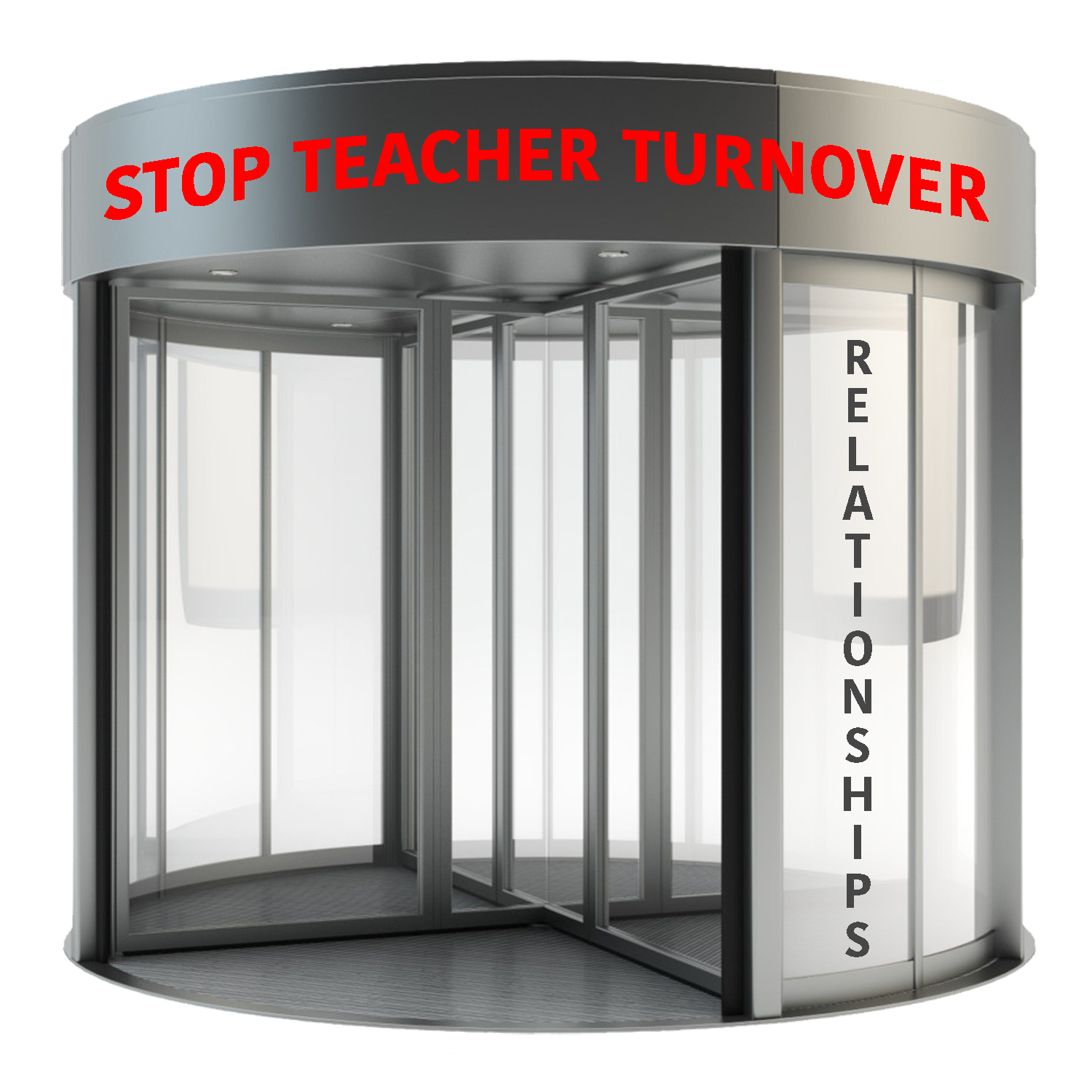
As we look at schools, we must also look at the teacher turnover rate. (Illustration by: Folwell Dunbar)
The principal handed me a three-ring binder the size of an old New York City telephone book. “This is our Bible,” he said. “It has everything you need.”
I was part of a school review team. We had been asked to “evaluate” the school and provide its leadership team with constructive feedback.
The “Bible” was filled with student performance data, spreadsheets, bar graphs, scatter plots and growth projections. It had BHAGs (Big, Hairy Audacious Goals), benchmark, Advanced Placement and other standardized testing scores, college acceptance and dropout rates. It was the gospel according to Big Data.
After several hours of sifting through the minutia, I noticed that something was missing. There was no mention of teacher turnover. I found this strange.
When I asked the principal about the omission, he fired back, “Our goal is to get kids into college, not to keep adults employed.”
He then mashed together three horse analogies: “We hire stallions and let them run. We ride them hard, and put them up wet. If they can’t finish the race, we simply put them out to pasture.”
He concluded with a “slam dunk” sports analogy: “I’m like Coach K at Duke University. ‘One and done’ is only a problem if I can’t win a championship, or, if I can’t reload.” (Author’s Note: Coach K recently denounced ‘one and done.’ He actually believes that athletes (students) benefit from staying longer.)
I thought to myself, “Was the principal right? Does teacher retention really matter? And, if it does, why and what can be done to improve it?”
The Data in Relationships
I attended a small New England boarding school. It had great teachers, incredible resources and a beautiful campus. It was an idyllic place to learn.
I was lucky.
Looking back on my experience at Brooks School in North Andover, Massachusetts, I don’t recall many (if any) standardized tests. I also don’t remember an “Excel Spreadsheet Bible.” What I do remember (and cherish most) were the relationships, especially those with my teachers and coaches.
I went birding with Mr. Burgess, my Ancient History teacher; I listened to Bob Dylan late at night with Mr. Poirot, my dorm master, advisor and football coach; I had long heated discussions about Mere Christianity and Siddhartha with “The Rev;” and I spent two hours a day wearing an unflattering singlet (Is there really any other kind?) in a hot, sweaty wrestling room with Mr. Ward, my coach and English teacher.

The author (center right) with his football coach, Latin teacher and mentor, Bill Poirot. (Photo provided by: Folwell Dunbar)
Over time, I got to know them well, and they got to know me. The “data” they gleaned from our relationship helped them better support me as a student and as young man. They became mentors, role models, foster parents and friends.
Fortunately for me, teacher turnover at Brooks was not an issue. Knowing them for four years (and often long after) had a huge impact on my life.
The Teacher Turnover Crisis
When I was a principal, I had a teacher who was a rock star. She was one of the best I had ever seen. Halfway through her second year, she was poached by a school down the street. They offered her more money and better benefits. A year later, realizing that “the grass wasn’t greener on the other campus,” she left for another school. The year after that, she departed to pursue a doctorate in education.
Another rock star of mine left after three years because of an unwelcome administrative change. At her new school, she discovered that the its professed mission was not actually aligned with its practices. After only two years there, she set out in search of a “better fit.”

The author with with a few former students at his book signing. (Photo provided by: Folwell Dunbar)
I had four TFA or Teach For America teachers. After their Peace Corps-like two-year stint, two of them bolted for other careers. A year later, the other two were gone as well.
The causes for teacher turnover are as numerous and as varied as Crayola crayons.
They include burnout and boredom, lack of respect or opportunities for advancement, poor performance and/or “bad chemistry.” A recent Education Week survey listed the top three reasons as 1) salary, 2) school climate, and 3) level of autonomy.
According to educational researchers, Desiree Carver-Thomas and Linda Darling-Hammond, “Roughly 16 percent of teachers in the U.S. change jobs or leave the profession annually.” That amounts to approximately 260,000 teachers a year. The cost to replace a single teacher ranges from $9000 to $21,0000 (Edutopia, 2017).
Rates of attrition are highest among schools serving low-income students, i.e., schools that need good instruction and stability most; and shortages are greatest among subject areas like Science, Special Education and Foreign Languages, i.e., subjects the United States lag behind the rest of the world.
In addition to the obvious economic bourdon, teacher turnover hurts a school’s professional culture, disrupts the educational process, and contributes to the loss of institutional knowledge.
More importantly, teachers filing out a revolving door, undermines the formation relationships – relationships that could make all the difference in a child’s life.
Navigating ‘Angsty Wonder’
A classmate and friend of mine from Brooks, Leigh Perkins, is now a teacher at the school. Her parents had been teachers there as well. They spent their entire careers in North Andover (Her father, Skip Perkins had been one of my favorite football coaches.). When I asked Leigh why she and her parents had stayed at the school – and in the classroom, she replied, “It’s a combination of things. A deeply felt and well-developed sense of the school’s values and mission (having been a small part of developing it, and having lived it myself as a student), springing from the knowledge that they generally align with mine. A faith in my colleagues and my administrators that they trust and support my vision and approach. The comfort of a good track record, and the latitude that offers for creativity and experimentation. Volumes of anecdotal data that informs every new situation I come across and ads significantly in finding solutions. The joy of being in the same room with the kids, in all their messy and angsty wonder. I love them, and I love helping them through this moment in their lives. It’s that simple.”
When schools address the causes cited in the Education Week survey, when they pay teachers what they deserve, create a supportive professional learning culture, and give teachers the autonomy they crave, turnover is a non-issue. Note: Finland, a country with high teacher retention rates and high test scores, does all three.
Contrary to the bluster from school administrators at “no excuses” schools, teacher retention data does matter. It belongs in “The Bible.”
Keeping teachers in the classroom, especially those who are highly effective, makes a difference, a big difference.
Among other things, it allows them to forge meaningful and lasting relationships with their students. The ‘data’ in these relationships easily justifies the fight against teacher turnover.
Author’s Note: The challenges facing public and private schools can be vastly different. With that said, teacher retention is important for both. Relationships between teachers and students make a difference in ALL schools.
Folwell Dunbar is a former Peace Corps volunteer, teacher, coach and principal. He is the author of the book, He Falls Well: A Memoir of Survival. He can be reached at fldunbar@icloud.com
 NOLAbeings Multimedia artist Claire Bangser created NOLAbeings as a portrait-based story project that marries...
NOLAbeings Multimedia artist Claire Bangser created NOLAbeings as a portrait-based story project that marries...  Voodoo in New Orleans: Reviving history: New Orleans fortune telling This article takes a deep dive into the history of Voodoo in New Orleans, its hybridization with Catholicism, and its present-day place in the city's culture. The author visits fortune-tellers in the French Quarter, using their guidance as a tool for introspection rather than a deterministic predictor of the future. Through her experiences in New Orleans, the author feels a mystical connection to both the past and the future.
Voodoo in New Orleans: Reviving history: New Orleans fortune telling This article takes a deep dive into the history of Voodoo in New Orleans, its hybridization with Catholicism, and its present-day place in the city's culture. The author visits fortune-tellers in the French Quarter, using their guidance as a tool for introspection rather than a deterministic predictor of the future. Through her experiences in New Orleans, the author feels a mystical connection to both the past and the future. 